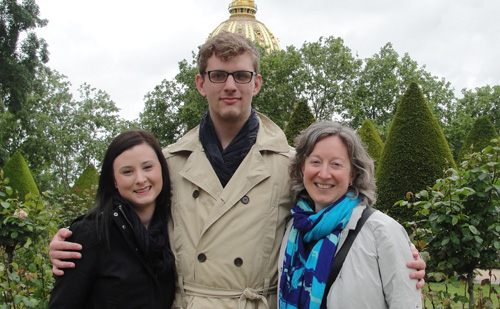
Master’s student Brandon Carroll had arrived at the Archives et musée de la littérature in Brussels hoping he could find the journals of Georges Eekhoud, the author who is the focus of Carroll’s major research paper. Carroll is particularly interested in the author’s life and writings as a gay man.
Getting the journals took some time, but when he finally held them in his hands, he was pleased to see that Eekhoud had created a table of contents for each of the 30 notebooks.
That pleasure soon turned to disappointment. “When I went to look at the sections about his lover and his travels in Italy, for example, I found that the pages had either been ripped out of the journal, or scribbled over to obliterate the words,” Carroll says. “I could just barely make out part of one sentence. It was very discouraging.”
Carroll and classmate Kylee Erwin had travelled to France and Belgium with French and European studies professor Margot Irvine. The two students soon discovered that research wasn’t always quite what they’d imagined. Documents they needed might be lost, destroyed or deliberately defaced.
“Some days are disappointing,” says Carroll. “You can spend a whole day reading through papers and not finding anything useful. But other times it is exciting: you feel like Indiana Jones discovering something new. ” He unexpectedly found documentation about Jane Dieulafoy’s research process among studies she had assembled about cross-dressing.
Erwin, who was looking through papers and correspondence to and from Judith Cladel at the Rodin Museum in Paris, says just searching through documents can be a challenge. “I got boxes with piles of letters of all different shapes and sizes, and all written in different handwriting. The paper was sometimes very fragile.” She had to be very cautious about opening and handling the letters, and was sometimes puzzled by the various handwriting styles.
“If you are reading a bunch of documents written by the same person, you get used to their writing style,” she explains. “But these were letters from different people writing to Cladel, so each time I had to adjust to their handwriting.”
It was worth the effort, though: Irvine, Erwin and Carroll found fascinating information that had never previously been studied about a court case brought by Cladel, who believed that Rodin had promised her the first curatorship at the Rodin Museum after the sculptor’s death.
The students were surprised to discover how different the rules were at each of the archives they visited. At the Bibliothèque de l’Institut in the French Academy, for example, they had to obtain letters of authorization from a member of the academy before they could enter. In some archives, the rules were very strict. “We were scanned just as for airport security,” says Carroll. “You definitely got the sense that they are guarding national treasures.”
Gloves or special holders were required when handling documents, and they were not allowed to bring pens or drink water.
Contrast this to another library, which Carroll describes as “chaos.” The reading room was unsupervised, and Carroll saw people drinking Coke while reading 150-year-old documents; Irvine recalls someone eating pizza in the reading room. Some libraries had the documents digitized or on microfilm; others shared the originals. Some allowed photos to be taken; others did not, or they put strict limits on photography.
Erwin says she was surprised by how distracting – and rewarding – being in another country could be. “It was hard to concentrate when Paris was right outside the door,” she says. Irvine and her students had arrived during a turbulent time: a law allowing same-sex marriage, known as le mariage pour tous, was passed. Carroll and Erwin attended a concert that celebrated the new law but they also encountered large protests against it.
“I felt quite uneasy and overwhelmed walking through one of the protests, called la manif pour tous,” says Erwin. “It was a very large crowd of very angry people gathered near my apartment.”
Carroll was fascinated by the graffiti from both sides: “Adam et Yves” and “On veut du boulot, pas du mariage homo” (We want jobs, not gay marriage). “I took photos of all of it,” he says.
Both add, though, that their exposure to French culture was an important part of their experience, and Irvine agrees: “I have been researching in France for years, but had never brought students to these archives before. We also visited some art galleries, a rare book market and other sites. It was fun to see Paris through their eyes.”
Irvine’s research, funded by the Social Sciences and Humanities Research Council, explores the literary prize known as the prix Femina, and Erwin’s major paper will be about Louise Cruppi, an author who was a juror on the prix Femina committee. Jane Dieulafoy, whose records included the cross-dressing information Carroll was looking for, was also a member of that committee, as was Judith Cladel.
For the students, spending this time in the archives has given them a new perspective on the value of doing original research. As Carroll says, “You are not just writing about something that has been done over and over. You are contributing in a real way to the advancement of knowledge.”